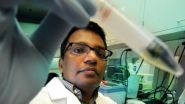(Press-News.org) PITTSBURGH—A smart headlight developed at Carnegie Mellon University's Robotics Institute enables drivers to take full advantage of their high beams without fear of blinding oncoming drivers or suffering from the glare that can occur when driving in snow or rain at night.
The programmable headlight senses and tracks virtually any number of oncoming drivers, blacking out only the small parts of the headlight beam that would otherwise shine into their eyes. During snow or rain showers, the headlight improves driver vision by tracking individual flakes and drops in the immediate vicinity of the car and blocking the narrow slivers of headlight beam that would otherwise illuminate the precipitation and reflect back into the driver's eyes.
"Even after 130 years of headlight development, more than half of vehicle crashes and deaths occur at night, despite the fact there is much less traffic then," said Srinivasa Narasimhan, associate professor of robotics. "With our programmable system, however, we can actually make headlights that are even brighter than today's without causing distractions for other drivers on the road."
Robert Tamburo, the project's lead engineer, will present findings from tests of the system in the lab and on the streets of Pittsburgh on Sept. 10 at the European Conference on Computer Vision in Zurich, Switzerland. More information, including a video, is available on the project website, http://www.cs.cmu.edu/smartheadlight/.
The system devised by Narasimhan, Tamburo and the rest of the research team uses a DLP projector instead of a standard headlight or cluster of LEDs. This enables the researchers to divide the light into a million tiny beams, each of which can be independently controlled by an onboard computer.
A camera senses oncoming cars, falling precipitation and other objects of interest, such as road signs. The one million light beams can then be adjusted accordingly, some dimmed to spare the eyes of oncoming drivers, while others might be brightened to highlight street signs or the traffic lane. The changes in overall illumination are minor, however, and generally not noticeable by the driver.
System latency — the time between detection by the camera and a corresponding adjustment in the illumination — is between 1 and 2.5 milliseconds, Tamburo said. This near-instantaneous reaction means that in most cases the system doesn't have to employ sophisticated algorithms to predict where an oncoming driver or a flake of snow will be by the time the headlight system responds.
"Our system can keep high beams from blinding oncoming drivers when operating at normal highway speeds," Narasimhan said. Rain and snow present a more difficult problem, he noted; the system reduces glare at low speeds, but becomes less effective as speed increases.
In addition to preventing glare, the projector can be used to highlight the traffic lane — a helpful driving aid when roads have unmarked lanes or edges, or when snow obscures lane markings. When tied to a navigation system, the programmable headlights also can project arrows or other directional signals to visually guide drivers.
"We can do all this and more with the same headlight," Narasimhan said. That's in contrast to new headlight systems that some automakers are installing. These include multi-LED systems that reduce glare to oncoming drivers by darkening some LEDs as well as swiveling headlights that help drivers see down curved roads. "Most of these are one-off systems, however, with different headlights required for different specialized tasks," he added.
The research team assembled their experimental system from off-the-shelf parts and mounted the system atop the hood of a pickup truck, serving as the equivalent of a third headlight during street tests. The team plans to install a smaller version next year in the headlight slot of a truck.
Though currently larger than standard headlights, Narasimhan said the smart headlights could be accommodated by trucks and buses, whose headlights are especially prone to causing glare because they are positioned high off the ground. Eventually, miniaturization should make the smart headlights compatible with smaller vehicles.INFORMATION:
The research team includes Takeo Kanade, professor of computer science and robotics; Anthony Rowe, assistant research professor of electrical and computer engineering (ECE); Abhishek Chugh, a master's degree student in computer science; Subhagato Dutta and Vinay Palakkode, both master's degree students in ECE; and Eriko Nurvitadhi and Mei Chen of Intel Research.
The research was supported by Ford Motor Co., the Intel Science and Technology Center for Embedded Computing, the Office of Naval Research and the National Science Foundation. It is part of the Technologies for Safe and Efficient Transportation Center, a U.S. Department of Transportation University Transportation Center at Carnegie Mellon.
The Robotics Institute is part of Carnegie Mellon's top-ranked School of Computer Science, which is celebrating its 25th year. Follow the school on Twitter @SCSatCMU.
About Carnegie Mellon University: Carnegie Mellon is a private, internationally ranked research university with programs in areas ranging from science, technology and business, to public policy, the humanities and the arts. More than 12,000 students in the university's seven schools and colleges benefit from a small student-to-faculty ratio and an education characterized by its focus on creating and implementing solutions for real problems, interdisciplinary collaboration and innovation. A global university, Carnegie Mellon has campuses in Pittsburgh, Pa., California's Silicon Valley and Qatar, and programs in Africa, Asia, Australia, Europe and Mexico.
Carnegie Mellon's smart headlights spare the eyes of oncoming drivers
Programmable lights prevent glare, improve vision in snow and rain
2014-09-09
ELSE PRESS RELEASES FROM THIS DATE:
New molecular target is key to enhanced brain plasticity
2014-09-09
As Alzheimer's disease progresses, it kills brain cells mainly in the hippocampus and cortex, leading to impairments in "neuroplasticity," the mechanism that affects learning, memory, and thinking. Targeting these areas of the brain, scientists hope to stop or slow the decline in brain plasticity, providing a novel way to treat Alzheimer's. Groundbreaking new research has discovered a new way to preserve the flexibility and resilience of the brain.
The study, led by Tel Aviv University's Prof. Illana Gozes and published in Molecular Psychiatry, reveals a nerve cell protective ...
Sharks in acidic waters avoid smell of food
2014-09-09
VIDEO:
A smooth dogfish shark attacks an odor cue at at Woods Hole Oceanographic Institution.
Click here for more information.
The increasing acidification of ocean waters caused by rising atmospheric carbon dioxide levels could rob sharks of their ability to sense the smell of food, a new study suggests.
Elevated carbon dioxide levels impaired the odor-tracking behavior of the smooth dogfish, a shark whose range includes the Atlantic Ocean off the eastern United States. Adult ...
Shared pain brings people together
2014-09-09
What doesn't kill us may make us stronger as a group, according to findings from new research published in Psychological Science, a journal of the Association for Psychological Science.
The research suggests that, despite its unpleasantness, pain may actually have positive social consequences, acting as a sort of "social glue" that fosters cohesion and solidarity within groups:
"Our findings show that pain is a particularly powerful ingredient in producing bonding and cooperation between those who share painful experiences," says psychological scientist and lead researcher ...
Exercise before school may reduce ADHD symptoms in kids
2014-09-09
EAST LANSING, Mich. – Paying attention all day in school as a kid isn't easy, especially for those who are at a higher risk of ADHD, or attention deficit hyperactivity disorder.
A new study from Michigan State University and University of Vermont researchers shows that offering daily, before-school, aerobic activities to younger, at-risk children could help in reducing the symptoms of ADHD in the classroom and at home. Signs can include inattentiveness, moodiness and difficulty getting along with others.
The study can be found in the Journal of Abnormal Child Psychology.
"Early ...
Scientists discover hazardous waste-eating bacteria
2014-09-09
Tiny single-cell organisms discovered living underground could help with the problem of nuclear waste disposal, say researchers involved in a study at The University of Manchester.
Although bacteria with waste-eating properties have been discovered in relatively pristine soils before, this is the first time that microbes that can survive in the very harsh conditions expected in radioactive waste disposal sites have been found. The findings are published in the ISME (Multidisciplinary Journal of Microbial Ecology) Journal.
The disposal of our nuclear waste is very challenging, ...
Estrogen receptor expression may help explain why more males have autism
2014-09-09
AUGUSTA, Ga. – The same sex hormone that helps protect females from stroke may also reduce their risk of autism, scientists say.
In the first look at a potential role of the female sex hormone in autism, researchers at the Medical College of Georgia at Georgia Regents University have found expression of estrogen receptor beta – which enables estrogen's potent brain protection – is significantly decreased in autistic brains. The receptor also plays a role in locomotion as well as behavior, including anxiety, depression, memory, and learning.
"If you ask any psychiatrist ...
Phosphorus a promising semiconductor
2014-09-09
Defects damage the ideal properties of many two-dimensional materials, like carbon-based graphene. Phosphorus just shrugs.
That makes it a promising candidate for nano-electronic applications that require stable properties, according to new research by Rice University theoretical physicist Boris Yakobson and his colleagues.
In a paper in the American Chemical Society journal Nano Letters, the Rice team analyzed the properties of elemental bonds between semiconducting phosphorus atoms in 2-D sheets. Two-dimensional phosphorus is not theoretical; it was recently created ...
A system that facilitates malware identification in smartphones
2014-09-09
Malware is a type of malicious program whose general aim is to profit economically by carrying out actions without the user's consent, such as stealing personal information or committing economic fraud. We can find it "in any type of device ranging from traditional cell phones to today's smartphones, and even in our washing machine," explained one of the researchers, Guillermo Suarez de Tangil, from the Computer Science Department at UC3M.
With the massive sales of smartphones in recent years (more than personal computers in all of their history), malware developers ...
Testing the fossil record
2014-09-09
Palaeontologists have developed methods to try to identify and correct for bias and incompleteness in the fossil record. A new study, published on 4 September 2014 in the journal Nature Communications, suggests that some of these correction methods may actually be misleading. The work is led by Dr Alex Dunhill (University of Leeds, formerly at the Universities of Bath and Bristol), together with Hannisdal (University of Bergen) and Professor Michael Benton (University of Bristol).
Back to the origin of animals
"The Earth keeps changing. Life keeps evolving. And there ...
How age alters our immune response to bereavement
2014-09-09
Young people have a more robust immune response to the loss of a loved one, according to new research from the University of Birmingham, providing insight into how different generations cope with loss.
The study, published in the journal Immunity and Ageing, shows how the balance of our stress hormones during grief changes as we age – meaning elderly people are more likely to have reduced immune function and, as a result, suffer from infections.
It is the first research to compare different generations and display the relationship between stress hormones and immune ...
LAST 30 PRESS RELEASES:
Numbers in our sights affect how we perceive space
SIMJ announces global collaborative book project in commemoration of its 75th anniversary
Air pollution exposure and birth weight
Obstructive sleep apnea risk and mental health conditions among older adults
How talking slows eye movements behind the wheel
The Ceramic Society of Japan’s Oxoate Ceramics Research Association launches new international book project
Heart-brain connection: international study reveals the role of the vagus nerve in keeping the heart young
Researchers identify Rb1 as a predictive biomarker for a new therapeutic strategy in some breast cancers
Survey reveals ethical gaps slowing AI adoption in pediatric surgery
Stimulant ADHD medications work differently than thought
AI overestimates how smart people are, according to HSE economists
HSE researchers create genome-wide map of quadruplexes
Scientists boost cell "powerhouses" to burn more calories
Automatic label checking: The missing step in making reliable medical AI
Low daily alcohol intake linked to 50% heightened mouth cancer risk in India
American Meteorological Society announces Rick Spinrad as 2026 President-Elect
Biomass-based carbon capture spotlighted in newly released global climate webinar recording
Illuminating invisible nano pollutants: advanced bioimaging tracks the full journey of emerging nanoscale contaminants in living systems
How does age affect recovery from spinal cord injury?
Novel AI tool offers prognosis for patients with head and neck cancer
Fathers’ microplastic exposure tied to their children’s metabolic problems
Research validates laboratory model for studying high-grade serous ovarian cancer
SIR 2026 delivers transformative breakthroughs in minimally invasive medicine to improve patient care
Stem Cell Reports most downloaded papers of 2025 highlight the breadth and impact of stem cell research
Oxford-led study estimates NHS spends around 3% of its primary and secondary care budget on the health impacts of heat and cold in England
A researcher’s long quest leads to a smart composite breakthrough
Urban wild bees act as “microbial sensors” of city health.
New study finds where you live affects recovery after a hip fracture
Forecasting the impact of fully automated vehicle adoption on US road traffic injuries
Alcohol-related hospitalizations from 2016 to 2022
[Press-News.org] Carnegie Mellon's smart headlights spare the eyes of oncoming driversProgrammable lights prevent glare, improve vision in snow and rain





